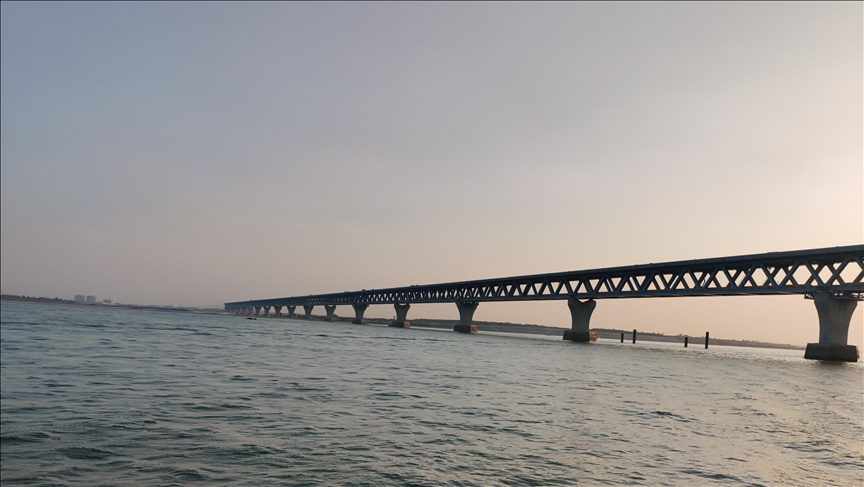Bangladesh's longest bridge opens avenues for expanding industrialization, connectivity
After World Bank withdrew funds in 2012, South Asian nation completed project with own funds

DHAKA, Bangladesh
Following a decade-long predicament over the withdrawal of international funding due to graft allegations, Bangladesh has completed the construction of the country’s longest bridge, the Padma Multipurpose Bridge, providing the scope for expansion in industrialization and regional connectivity.
"This mega-project will help us decentralize a huge number of our industries and set up new industries in the country’s south and southwestern coastal regions," Moshiur Rahman, economic affairs adviser to Prime Minister Sheikh Hasina, told Anadolu Agency.
Referring to the country's main foreign exchange earner, the readymade garment (RMG) industry, he said most of the nation’s knitwear and garment facilities are located in the capital Dhaka and the port city of Chattogram.

"But we will be able now to set up many RMG and other industries in the south and southwestern parts."
Recalling jute, the once "golden fiber” and prime export item, he added: "Although the jute industry is not doing well now, after this connectivity, we are hopeful of resuscitating this industry, and it will boost the country's economy a lot."
Bangladesh is currently handling most of its export and import activities through Chattogram Port, while the southwestern Mongla Port is functioning on a limited scale due to a lack of roads. The country is also building two other seaports -- Matarbari and Payra.
"After the construction of the Padma Bridge, all four of these ports will be effectively connected with each other and with Dhaka, while the long isolation of the country’s 21 coastal districts and more than 42 million people will be ended," said Rahman.
Less time on the roads
Showkat Bhuiyan, a resident of Shariatpur District in central Bangladesh and a small businessman in Dhaka’s Paltan precinct, told Anadolu Agency that after the inauguration of the Padma Bridge, he traveled to Dhaka from his village in only two hours.
“It was beyond my imagination that in such a short time I would be able to reach Dhaka from my village, while it frequently takes two to three hours to travel from one place to another within this overcrowded megacity,” Bhuiyan said.
Md. Kayum Hossain, who frequently comes to Dhaka to buy machinery tools for his business in the remote district of Barguna, normally uses a water ferry which is locally called a launch. The journey usually takes 15-17 hours.

“I came to Dhaka by bus after many years, and I arrived in only six hours. It’s amazing to me, as just within a day, I came to Dhaka and returned home after completing all my work,” Hossain said.
Millions of people in the country’s coastal areas can now easily visit Dhaka, the nerve center for all important dealings, no longer having to use water ferries in rough weather.
“But now we can go to Dhaka or any other place in the country at any time in case of emergency needs, including for treatment,” Mohammad Shahidul Islam, a private sector employee in Dhaka, told Anadolu Agency.
Regional connectivity
The Padma Bridge will not only boost national connectivity but will also help Bangladesh to be a significant center of regional communication.
A link road with the double-layer steel truss bridge, including a four-lane highway on the upper level and a single-track railway on the lower level, will connect with the trans-Asian highway and railway networks. It will strategically strengthen Bangladesh in the region.
“Our connectivity with India, Myanmar, China, and the rest of the region will be smoothened and it will push the country’s economy to a new height,” Rahman said.
Challenge accepted
Prime Minister Hasina on Saturday inaugurated the 6.15-kilometer-long bridge, costing a record $3.87 billion, with hundreds of thousands of people attending.
Brushing aside the corruption allegations raised by the World Bank a decade ago in connection with its developer, Hasina described the bridge as “a symbol of Bangladesh’s pride, honor, and ability” during her inaugural speech.
The country’s major development partner withdrew from a $1.2 billion loan agreement for the project in 2012 on allegations of corruption. Other partners including the Asian Development Bank (ADB) and Japan International Cooperation Agency (JICA) followed suit.
Saying the move by the development partners was based on false and fabricated charges, Bangladesh boldly declared that it would complete the crucial project with its own funds.
After several hiccups, Bangladesh finally succeeded in completing it with technical support from China’s state-owned Railway Major Bridge Engineering Group (RMBEG) along with 1,200 Bangladeshi engineers.
Anadolu Agency website contains only a portion of the news stories offered to subscribers in the AA News Broadcasting System (HAS), and in summarized form. Please contact us for subscription options.







